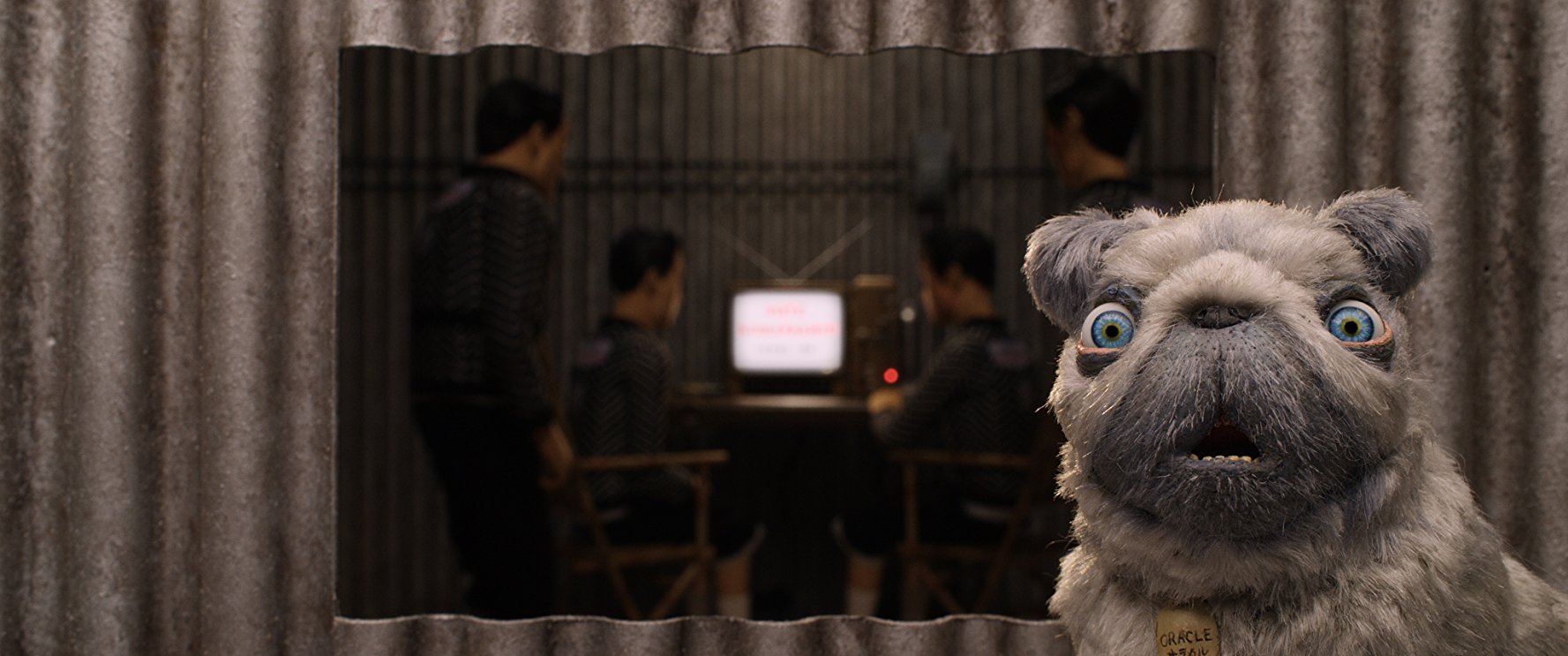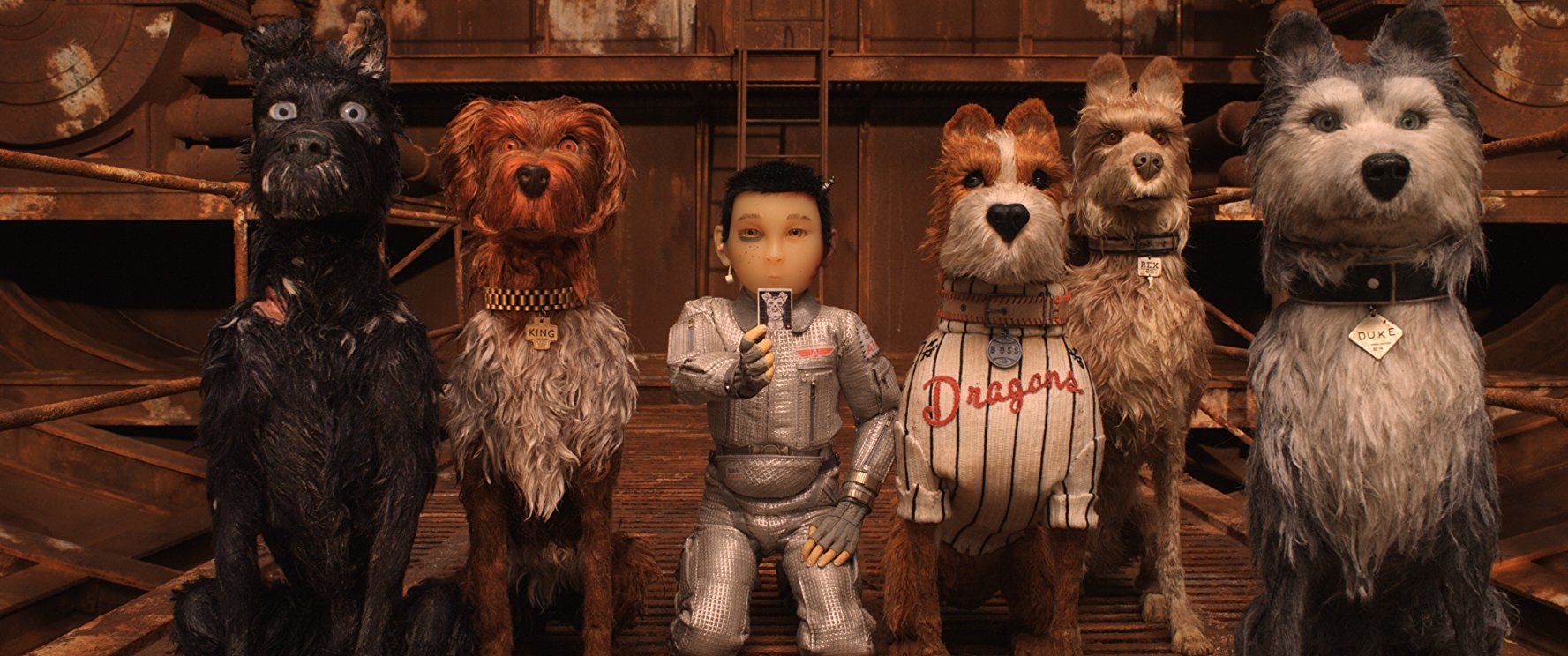Photo credit: Fox Searchlight
Wes Anderson hit gold with his first foray into stop-motion, Fantastic Mr. Fox. As a lover of animation, including stop-motion animation, this instantly became one of the all-time favorite movies. Not only was the animation top-notch and extremely tactile, the medium of stop-motion somehow channeled all of Anderson’s directorial and storytelling tics into something much more streamlined and meaningful. Many have rightly said that perhaps the medium suits Anderson best because his directorial style is very much like watching someone play with dolls–everything, from the script to the tilt of an actor’s head, is highly curated and manicured within an inch of its life.
I’d hoped that Anderson would access that same type of magic with Isle of Dogs. It certainly looked like it could have the same amount of charm as Fantastic Mr. Fox. But a lot of the Anderson charm has been overshadowed by Anderson’s lack of cultural understanding. If you aren’t aware, Isle of Dogs is inexplicably set in Japan, and not just regular Japan, but a futuristic dystopian Japan. To make matters worse, the film’s story takes place in the fictional town of Megasaki (a name that evokes an American otaku‘s vision of a futuristic Japan overrun with Gundam-like mechs) and centers around a child named Atari (Koyu Rankin), as in the video game company. The cherry on top is that us non-Japanese speaking viewers can’t understand anything the Japanese characters are saying; while all of their dialogue is in their native language, there aren’t any subtitles, leaving us out of the jokes and making human characters seem much more foreign than the dogs, who are made to be sound much more human. Oh also: there’s a white savior element in the form of exchange student Tracy (Greta Gerwig).
I could go on and tell you why these elements of the films are big problems, but these six film critics can get into the nitty gritty of it better than I can. So I give the floor over to them.
“I couldn’t tell if it was a case of laughing with or at a non-English-speaker.”
“…I was deeply uncomfortable listening to the majority white audience laugh when Japanese characters like Mayor Kobayashi would speak. I’m assuming they didn’t understand what he was saying but found the caricature of a foreign autocrat amusing. There was even more laughter whenever a Japanese speaker used wasei-eigo (spoken “loan words” from English) because I guess it’s funny-sounding. I couldn’t tell if it was a case of laughing with or at a non-English-speaker, and I found Anderson’s lack of consideration for that blurred line to be troubling.
What’s more, the rationale for the language barrier—that this is a story from the dogs’ point of view—falls apart once the film introduces Tracy [a white character played by Greta Gerwig], who demonstrates some knowledge of Japanese but speaks most of her dialogue in English, even to the people of her host country. It also tells us all we need to know about whose voices Anderson values the most, whose emotions and thoughts he feels are important for his audience to comprehend: the white actors/characters.” –Mimi Wong, Mediaversity Reviews

“In the end, Japanese characters hardly factor into the story about Japan, other than as props.”
“The way that the story essentially shelves Atari for the back half of the film only makes things worse. Rather than sticking with Atari, the film’s focus shifts to Tracy (Greta Gerwig), an American exchange student who browbeats first her meek Japanese classmates and then the meek Japanese public into taking action for the sake of the dogs. It’s the classic white savior trope, and it feels no less egregious in Isle of Dogs than anywhere else. In the end, Japanese characters hardly factor into this story about Japan, other than as props. Though “cultural appropriation” may seem overly harsh as a way to describe the film, on the purest level, it’s absolutely true.”-Karen Han, The Daily Beast
“Why do I find myself cringing so hard at the way it reduces an entire nation’s history and character to the equivalent of an album’s deep-cut?”
I love so much in Isle of Dogs. I am moved by it. So why do I find myself cringing so hard at the way it reduces an entire nation’s history and character to the equivalent of an album’s deep-cut? Yes, it’s easy to read what Anderson & co. are doing as an homage to his hermetic ideas of the land of the rising sun rather than a racist Orientalism caricature along the lines of, say, those old Fu Manchu movies of the 1930s or Mickey Rooney’s buck-toothed landlord from Breakfast at Tiffany’s. (We’re not dignifying this with a link, you’ll have to seek out this atrocity yourself.) It’s a little harder to acknowledge that there’s a tourist-y tone-deafness that comes as part of the package. Harder, but necessary. You don’t get one without the other here.”–David Fear, Rolling Stone
“If Rankin-Bass were to do ‘The Rachel Dolezal Story,’ they could hire Tracy.”
Far, far more problematic is the character of Tracy (voice of Greta Gerwig). Tracy is an exchange student investigating the ouster of dogs for the school newspaper. She’s the only White person in “Isle of Dogs” and she is the film’s White savior. It is she who rallies the protesters against the mayor, raising her hand in what looks suspiciously like the Black Power salute (which, if you recall, Anderson last rendered on a wolf in “Fantastic Mr. Fox”). Speaking of Black Power, Tracy sports a hairstyle you’d normally find on Black people or, in a less extreme fashion, on Art Garfunkel. If Rankin-Bass were to do “The Rachel Dolezal Story,” they could hire Tracy, though in Ms. Dolezal’s defense, she’d at least know how to make an Afro look convincing.–Odie Henderson, Roger Ebert

“…Coy linguistic layers [reduce] the hapless, unsuspecting people of Megasaki to foreigners in their own city.”
“…[T]ellingly, it’s in the director’s handling of the story’s human factor that his sensitivity falters, and the weakness for racial stereotyping that has sometimes marred his work comes to the fore.
Anderson, a stickler for verisimilitude even in the weirdest situations, has the human residents of Megasaki City speak their native Japanese, a choice that would seem respectful enough except for the conspicuous absence of English subtitles. Much of the Japanese dialogue, especially Atari’s, has been pared down to simple statements that non-speakers can figure out based on context and facial expressions; longer, more complicated exchanges are translated aloud by a handy on-screen English interpreter (Frances McDormand).
The dogs, for their part, all speak clear American English, which is ridiculous, charming and a little revealing. You can understand why a writer as distinctive as Anderson wouldn’t want his droll way with the English language to get lost in translation. But all these coy linguistic layers amount to their own form of marginalization, effectively reducing the hapless, unsuspecting people of Megasaki to foreigners in their own city.”–Justin Chang, The Los Angeles Times
“…[T]he U.S. is maybe the last country on earth that should be preaching about how awful it would be if the Japanese carted off an unfairly maligned American-coded population to an internment camp.”
“Isle of Dogs seems to go out of its way to remove its Japanese trappings from their real-world context. The film embraces a 1960s aesthetic, but since it’s set in the 2030s, it’s free to make up its own history without worrying about whatever was actually going on in post-war Japan.
Or, for that matter, midcentury America. Watching Isle of Dogs, it’s hard not to think that the U.S. is maybe the last country on earth that should be preaching about how awful it would be if the Japanese carted off an unfairly maligned American-coded population to an internment camp. (Yes, the dogs are technically Japanese, but since they speak American English, they read to us, the American audience, as American characters by default.)”–Angie Han, Mashable

So there you have it. If you saw Isle of Dogs, what did you think about the Japanese representation? Give your opinions in the comments section below!
Loved this article? Follow JUST ADD COLOR at @COLORwebmag and on Facebook! If you want to support more writing like this, donate to my Ko-fi account!
